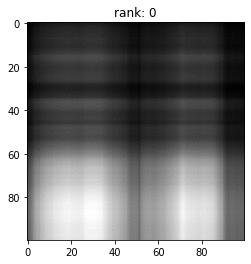Machine Learning Foundations
Tutorial - Week5

Arun Prakash A

Our Mind




Let's play a game
272
268
268
268
268
272
272
272
Image
- I am going to show you a sequence of images, one after another, that contains something.
- Task : Recognise the "thing" in the images. (Note down the sequence number)
- Let's go


My bad: Add +1 to the rank
What do you perceive?


What do you perceive?


What do you perceive?


What do you perceive?


What do you perceive?


What do you perceive?


What do you perceive?


What do you perceive?


What do you perceive?


What do you perceive?

Recognise the man in the picture


Recognise the man in the picture


Recognise the man in the picture


Recognise the man in the picture


Recognise the man in the picture


Recognise the man in the picture

Rank (k =50) Approximation


Of course, we lost some resolution (details)!
But not the gross information!
Image compression
272
268
268
268
268
272
272
272


272
268

Number of elements to be stored:
268*272 = 72,896
272
Original Image : (Without Compression)
Approx. Image :( or Compressed)
- For \(U\) : 268*15 = 4020
- For \(\Sigma\): \(k\) =15
- For \( V^T\) : 15*272 = 4080
- Total = 8115
- ~= 9 times reduction in required memory for storage
Well, but, hmm..How does it work?


The image is a linear combination of



It is zero by deafult!
Removes redundancy!
Tutorial - Week5

Arun Prakash A
Geometric Interpretation of SVD
SVD
Diagonal Matrix
- What happens if diagonal matrices act on a set of vectors in the canonical (standard) basis?
- Let us see it in \(\mathbb{R}^2\) with help of Geogebra applet :-)
Diagonal Matrices
Diagonal matrices preserves the direction of orthogonal vectors!
Why?
Similar Matrices
Geometry of SVD
Geometry of SVD

A quick summary:
- \(V^T\) Rotates disk D and basis \(e_1,e_2\)
- \(\Sigma\) scales the rotated disk D and \(\sigma_1,\sigma_2\) are semi-major and semi-minor axis of an ellipse (hyper-ellipse)
- \(U\) rotates the ellipse.
Source: Wikipedia




Tutorial - Week5

Arun Prakash A
Some questions to think and solve
High Dimensional Visualization
Geoffrey Hinton
"To deal with hyper-planes in a 14-dimensional space, visualize a 3-D space and say 'fourteen' to yourself very loudly. Everyone does it.
1. Is it possible to visualize complex vectors \(x_i \in \mathbb{C}^2\)geometrically as we do for real vectors ?. Pause the video and think about it.

We need 4 dimensions to visualize a vector from \(\mathbb{C}^2\)
Do complex matrices find any real world applications?

Is that just an abstract mathematical stuff?
Discrete Fourier Transform (DFT)
Countless Applications in signal processing, Digital communication, Speech processing ...
2.Compute the inner product between two vectors \(x= \begin{bmatrix}3-2i \\-2+i\\-4 - 3i \\ \end{bmatrix} \) and \(y=\begin{bmatrix}-2+4i\\5-i\\-2i\\ \end{bmatrix}\) and verify whether they are commutative (i.e. \(x \cdot y = y \cdot x\))
\( (3+2i) \times (-2+4i)\)
\( (-2-i) \times (5-i)\)
\( (-4+3i) \times (-2i)\)
= \( -14+8i\)
= \( -11-3i\)
= \( 6+8i\)

\( -19+13i\)
\( x \cdot y = x^*y=\bar{x}^Ty\)
\( y\cdot x = y^*x=\bar{y}^Tx\)
2.Compute the inner product between two vectors \(x=[3-2i,-2+i,-4 - 3i]^T\) and \(y=[-2+4i,5-i,-2i]^T\) and verify whether they are commutative (i.e. \(x \cdot y = y \cdot x\))
\( (3-2i) \times (-2-4i)\)
\( (-2+i) \times (5+i)\)
\( (-4-3i) \times (2i)\)
= \( -14-8i\)
= \( -11+3i\)
= \( 6-8i\)

\( -19-13i\)
\( y\cdot x = y^*x=\bar{y}^Tx\)
\(\overline{x \cdot y} \)
\( y\cdot x = y^*x=\bar{y}^Tx\)
\(x \cdot y \neq y \cdot x\)
Is it always true?
3. Prove that \(x \cdot y = \overline{y \cdot x}\) where \( x \in \mathbb{C}^n\) and \( y \in \mathbb{C}^n\)
\(\overline{y \cdot x} = \overline{\bar{y}x} \)
\( = \overline{\bar{y_1}x_1}+\overline{\bar{y_2}x_2} + \cdots +\overline{\bar{y_n}x_n} \)
\( =y_1\bar{x_1}+y_2\bar{x_2}+\cdots+y_n\bar{x_n} \)
\( =\bar{x_1}y_1+\bar{x_2}y_2+\cdots+\bar{x_n}y_n \)
\( = x \cdot y\)
4. Can we use inner product to compute (cosine) angle between two complex vectors, like we do for real vectors?
No!. Not Always
\( \frac{x \cdot y}{||x|| \ ||y||} \)
Let us reason why?
But some authors prefers
\( \frac{Re(x \cdot y)}{||x|| \ ||y||} \)
More details on it : Angles in complex vector space
5. Consider the matrix \(A = \begin{bmatrix}2& 3-3i \\ 3+3i & 5 \\ \end{bmatrix} \). Find the complex eigenvector for the eigenvalue \(\lambda=8\)
6. Let \(U = \begin{bmatrix} cos(t)& -sin(t) \\ sin(t) & cos(t) \end{bmatrix}\), show that the matrix \(U\) is unitary.
7. We know that \(U = \begin{bmatrix} cos(t)& -sin(t) \\ sin(t) & cos(t) \end{bmatrix}\),is unitary.Let us take a vector \(x \in R^2\) and see what happens when it get transformed by the \(U\).
MLF_Tutorial_5
By Arun Prakash
MLF_Tutorial_5
- 524



